SRNL Support to NA-24 in FY23
Savannah River National Laboratory
Programs To Advance International Nuclear Safeguards via NPAC
The Savannah River National Laboratory (SRNL) advances Nonproliferation and Arms Control (NPAC) missions by leveraging its knowledge and unique capabilities in nuclear material science and operations, nuclear processing, and arms control.
SRNL’s NPAC mission-supporting activities include:
- Reviewing export licenses and technology for proliferation risk. Researching and developing next generation safeguards.
- Researching and developing next generation nuclear materials management safeguards.
- Managing the U.S.-Russia Plutonium Production Reactor Agreement.
- Co-leading the Nuclear Compliance Verification, Plutonium Verification Team with PNNL.
- Supporting the International Atomic Energy Agency’s (IAEA) Network of Analytical Laboratories to aid in the early detection of misuse of nuclear material and provide credible assurances that states are honoring their safeguards obligations.
Key Accomplishments and Associated Impacts
NWAL Qualification
In FY23, after six years of research, development, and technological maturation, SRNL qualified as a microparticulate reference materials production laboratory as part of the IAEA’s Department of Safeguards’ Network of Analytical Laboratories (NWAL). SRNL qualified to produce microparticulate reference materials suitable for calibration and evaluating measurement quality. The SRNL-produced reference materials serve as an essential form of quality assurance and are critical to method development and assessing the traceability of measurement results from environmental sample analysis. These reference materials enable the IAEA to verify that nuclear material in non-nuclear weapon states remain compliant to the Nuclear Nonproliferation Treaty and to detect misuse of nuclear material and technologies at an early stage. Work with the IAEA was supported by NPAC’s Office of International Safeguards, Safeguards Technology program and the U.S. Department of State, Bureau of International Security and Nonproliferation.
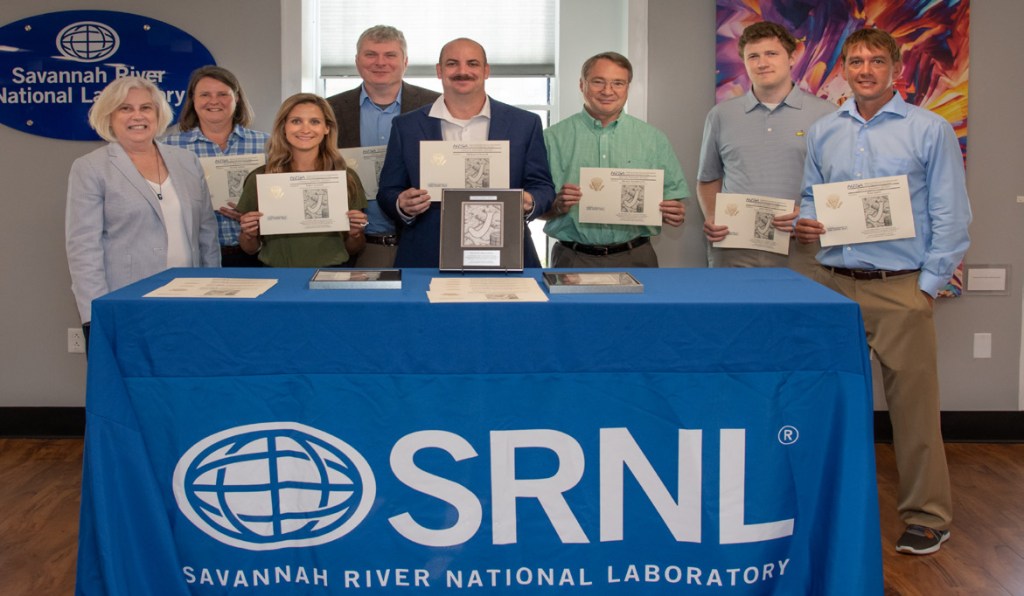
Members of the, now NWAL Qualified, Uranium Particle Production team receiving a Joule award from NNSA Office of International Safeguards, Safeguards Technology HQ Program lead, Arden Dougan.
Nuclear Suppliers Group Program Review
In May 2023, SRNL hosted 28 representatives from the National Nuclear Security Administration (NNSA), ANL, LANL, LLNL, SNL, PNNL, ORNL, SRNL, KCNSC, and the Department of Defense for the annual Nuclear Sup-pliers Group (NSG) Program Review (PR). The group discussed Nonproliferation and Arms Control (NPAC) priorities, the US technical agenda at the NSG, and collaborative proposal ideas for the FY24 funding cycle. SRNL experts provided briefings on the Commercial Tritium Market and Digital Control Systems in Nuclear Reactors. The presentations were followed by tours of the SRS Tritium Facility and Plant Vogtle. The NSG PR was an overwhelming success, receiving positive feedback from both the sponsor and participants.
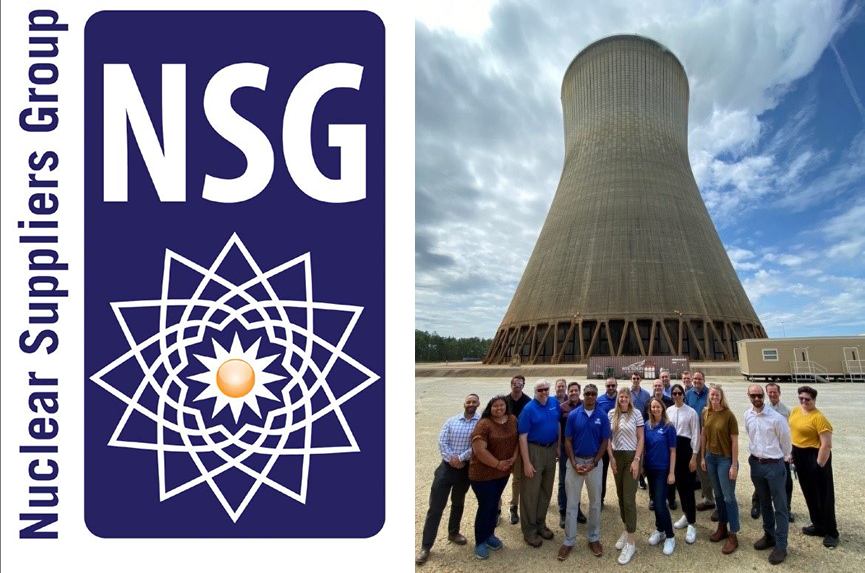
Participants at the 2023 NSG Program Review at Plant Vogtle.
Export Control, Review, Compliance, and Interdiction (ECRC/I)
During FY23, SRNL supported NA-242 Export Control, Review, Compliance, and Interdiction (ECRC/I) by providing technical support to export control case reviews, sanction reviews, IAEA Technical Cooperation project re-views, and interdiction teams. SRNL hosted a visit for ECRC/I Director Drew Bayliss, during which he reviewed current SRNL support operations and worked with staff to develop new opportunities for ECRC/I support, spe-cifically in supply chain management. Throughout FY23, SRNL assisted in development of a export license template and prepared in-depth technical reviews for export license cases directed to the Operating Committee for Export Policy (OC). SRNL reviewed and submitted analyses to NA-24 for the chemical/biological Iran North Korea and Syria Nonproliferation Act (INKS-NA) 2021B cases, reviewed Technology Transfer Working Group (TTWG) cases, supported the State Department-led Nuclear Interdiction Analysis Group (NIAG) and Shield interdiction groups by providing technical analyses that resulted in NIAG-generated Cleared Language Requests (CLRs), Shield generated Foreign Disclosure Requests (FDR), and State Department dé-marches. SRNL performed bimonthly reviews of ongoing IAEA Technical Co-operation Program (TCP) projects by procurement examinations, scientific and expert visits, fellowships, meetings, workshops, and training courses.
Human Capital Development
Funding from the NA-241 Human Capital Development (HCD) pro-gram allowed SRNL lab personnel and NNIS fellows to participate in additional training activities during FY23. These efforts serve to build the size, quality, and expertise of the SRNL and NPAC safeguards workforce. With HCD support, the skillset and knowledge base of SRNL’s staff supporting Safeguards activities were enhanced with courses at DOE sites through domestic nuclear facility experience courses and hands-on Secondary Ion Mass Spectrometry (SIMS) training. Emerging needs for ongoing IAEA-supporting Department of State and NPAC Safeguards’ Technology projects were addressed by providing SIMS user training and supporting coursework at the University of Minnesota for early and mid-career staff. Additionally, SRNL continued to support the Office of International Nuclear Safeguards’ NNIS Fellowship; the NNIS fellowship’s success in fostering the growth and development of the next generation of safeguards professionals in line with NPAC and NA241 HCD goals was highlighted during the 2023 INMM/ESARDA conference in Vienna.
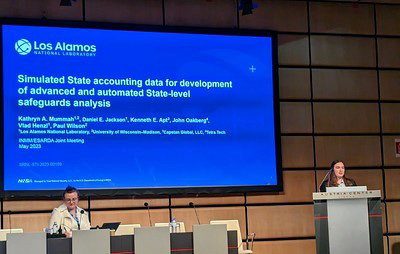
NNIS Fellow Kathryn Mummah presenting her research at the INMM/ESARDA conference in Vienna, Austria
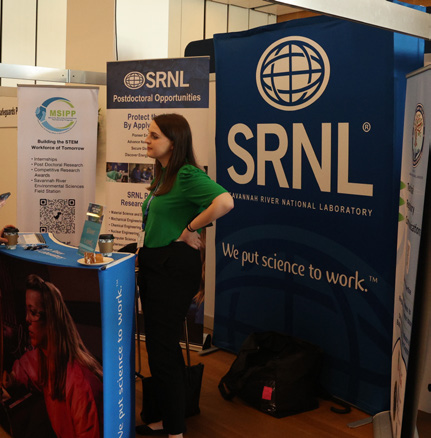
SRNL Global Security Directorate Staff member hosting the SRNL booth at INMM
SRNL Wide-Area Environmental Sampling (WAES)
To meet IAEA needs for ambient air collection and safeguards verification via Wide-Area Environmental Sampling (WAES), SRNL serves as a member of an NPAC organized multi-laboratory team (in partnership with DOE and other USG stakeholders) tasked with performing a series of tabletop exercises and limited field campaigns to evaluate ambient air sample collection and analysis methods. Building on success in FY22 to build a prototype high-volume air collector, in FY23 SRNL engineers and scientists evaluated potential systems, designed an electrostatic precipitator collector utilizing commercial off-the-shelf components, and made improvements to existing systems designed to enhance their operations and meet IAEA needs. More-over, SRNL engineers collaborated with Oak Ridge National Laboratory to incorporate a smart controller for remote monitoring of on-site meteorological data. To date, four First Article Collectors have been built to support a limited field campaign.
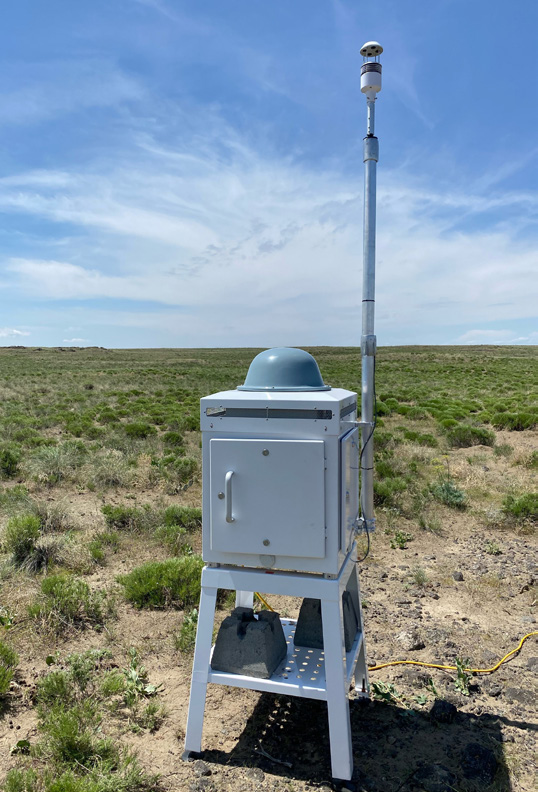
SRNL First Article Collector
K-Area Dilute/Disposal
SRNL continues to support the dilute/disposal efforts of nuclear materials at K-area, providing ongoing service to NA-241 and Office of Material Man-agement and Minimization (M3) to meet IAEA needs and requirements. The United States has committed to dilute and dispose of surplus Plutonium from the Savannah River Site as Transuranic waste at the Waste Isolation Pilot Plant (WIPP) in Carlsbad, N.M.. SRNL and SRS insight and expertise from experience with Voluntary Offer Agreement (VOA) inspections and IAEA safeguards and surveillance measures are essential to ensure that U.S. commitments and international safeguards obligations are maintained as dilute and disposal activities continue.
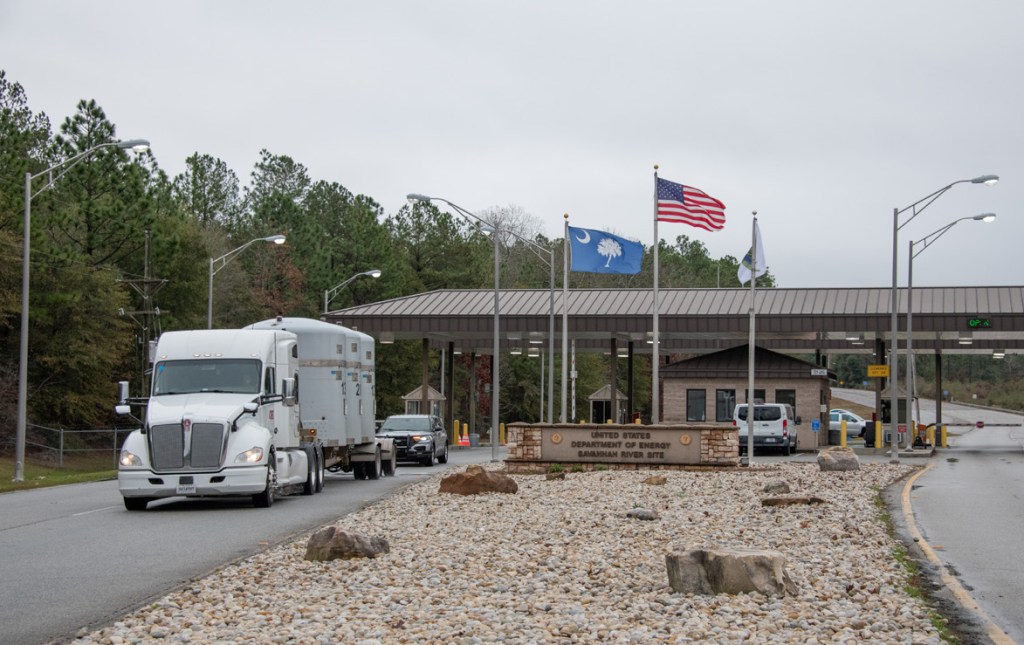
The first shipment of down blended surplus plutonium from the K Area at Savannah River Site in South Carolina departs the site enroute to the Waste Isolation Pilot Plant in New Mexico.
Plutonium Verification Team (PVT)
Three SRNL staff members provide extensive support to the PVT mission. One staff member is one of three PVT co-leads and the other two SRNL staff members are PVT team members. In FY23, the SRNL representatives participated in three major exercises that allowed PVT members to test their equipment and method-ology in real-world scenarios. One operation had staff continuously monitor operations at a reprocessing and plutonium production facility at Sellafield, United Kingdom for 48 hours. A second joint exercise with LANL utilized the SRNL Mobile Plutonium Facili-ty to conduct Non-Destructive Assay (NDA) of source mate-rials and refresh the team’s knowledge of the Advanced Spent Fuel Rod Counter. The third operation was another multi-lab exercise at PNNL, which reviewed techniques to characterize a foreign nuclear waste facility. Additionally, the SRNL team co-lead is heavily involved with planning future exercises, team activities, overall management of team personnel and activities. This includes events such as pre-visits schedule to sites both domestic and foreign, including one to the Institute of Nuclear Physics in Uzbekistan.
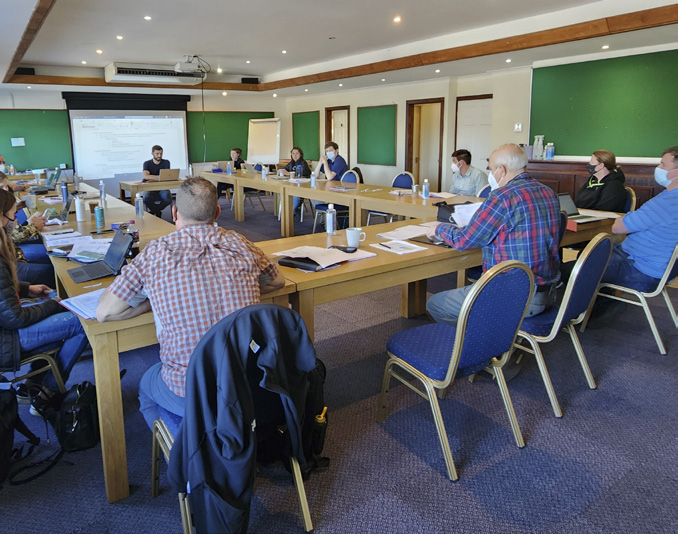
The PVT team preparing for the 48-hour monitored operations activity at Sellafield.